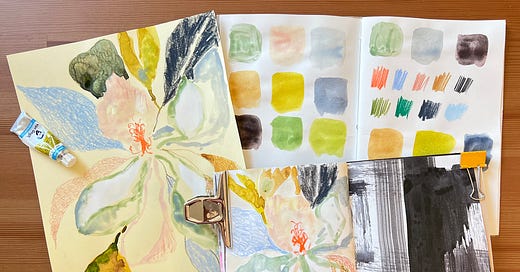I took my time to think about AI and I wanted to see how the technology and its implementation would evolve. I’m very aware that there are no easy answers, but AI as a technology is here to stay, that’s for sure. You are free to choose whether to use it in any capacity or to ignore it completely in your creative practice, but by now it’s so ubiquitous that it’s almost impossible to avoid it in our lives. My own opinion is that it is a double-edged sword, because it bears the potential to increase efficiency (I mostly mean e.g. routine business tasks), but also can harm creatives either through exploiting their work without remuneration, or through substituting their work.
Saying that, I want to emphasize that cheap substitutes for artwork have been around for decades - think various prints from supermarkets, stock images, mass produced cheap decoration pieces, etc. Even flea market and second hand pieces fall under this category. I don’t think these products are in direct competition with artworks that have a premium on their originality and uniqueness, although they still are substitutes. I think there have always been separate market niches for people looking for a cheaper way to decorate a space (e.g. art for a rental unit) and for people who think about themselves as art collectors and art enthusiasts.
Growing up we had only original art on our walls, either from my dad’s local artist friends or his own photos, but not everyone is selective about decorating their homes, many people enjoy simpler ways of doing that (which is fine, btw). There are people who want to have art on their walls, but don’t want to pay the price for original works of art. That’s where mass produced artworks that appeal to a wider audience come into play. And honestly, I think it’s these kind of products that AI is endangering the most, because people who weren’t buying original art anyway (with or without AI) were never an artist’s target audience.
Value of original art
When it comes to original art the main “selling point” isn’t only the art itself as a physical object, but it’s also the story of the artwork and of the artist, it’s how the artwork makes them feel and how they react to it - the authenticity and human component behind the art.
People want to know why and how the artist created the artwork, and also add their own angle and perspective, assign new meaning to it based on their own life and experiences. Human made art is both tactile - full of physical layers - and at the same time full of layers of meaning behind it, as Nick Wilton calls it “the seen and the unseen”.
There is no unseen in AI generated art1, no layers of work, no remnants of the creative process, no history of planning and resolving the artwork, that’s why it mostly feels flat and uninteresting, if not distasteful.
What attracts us to original artworks?
Meaning behind the artwork - intended by the artist vs interpreted by the viewer.
Progression of ideas - from inspiration to a formed idea, from studies and sketches to a body of work, all what happens behind the scenes.
Themes that an artists explores, the aesthetic interpretation of those themes.
Expression - how an artist captures the sense of an object or place, how they express feelings through the physical media of art.
The story of the artist, seeing their development in retrospective, e.g. formation years and artistic influences, importance of perseverance, breakthroughs, failures, etc.
This basically means that artists need to convey all those layers of meaning to their audience, but let’s face the truth - there is nothing new in that. Artists always had to be able to present themselves through artist’s statements, descriptions of their process and body of work, etc. It becomes even more important in this age and time, and this is where we need to focus on - understanding ourselves and our art and being able to communicate it clearly in order to stand out.
Concluding thoughts
I myself made a conscious decision to use AI mainly as an efficiency tool for my university studies and my daily job, by outsourcing repetitive and routine tasks or helping me with digesting large amounts of text, tackling translations for the website I do admin for, etc. And I must say it is very helpful.
However, I prefer to have an AI-free creative practice in both my paintings and my writing here on Substack, because I believe in the importance of creating artwork that has a strong human component in it. There is a specific reason why and how I create my paintings and I want to convey it using my own thoughts and words.
Further reading. I enjoyed these two articles on the topic: Art and Artificial Intelligence by
and The Future of Photography in the Age of AI by .Thank you for reading and being here! You’re very welcome in this space. Feel free to share this post with an art friend! I’ll be happy to hear from you in the comments, what do you think?
Until next time!
Lisa
AI art is an emerging branch and probably in a few years time we’ll all be alright in recognizing it as a valid separate category or genre (I’ve already seen it in exhibitions). Intention behind generating an image and creating specific prompts for the software can arguably be a source of additional meanings. All that being said, the main thing that has to be solved is using other artists’ work without permission and / or remuneration.






Your point about the see and unseen perspective is excellent.
Good topic! I once tried AI to help me design a figure for a painting but it was horrible. Now I hear that AI tools such as Midjourney has greatly improved so I might try it again but wary. Thanks for opening the conversation!